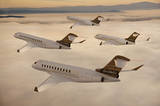
When a Chinese client asked for his interior "Bombardier" black carbon fiber, the designer was shocked, but pleased. "We'll do whatever you want, if it is within the certification," - says Sean Gillespie, executive vice president of sales for aviation services Flying Colours. Carbon fiber - a strong, tough but lightweight material used in tennis rackets and sneakers, and in the cars, but is quite expensive - 20 USD per kilogram. But fans of the composite material does not stop the price they bought the toilets and bathrooms are made of carbon fiber, which can cost up to 72 thousand USD.
Market for private aircraft - sometimes called a business or executive jets - a small but rapidly growing segment of aviation in China - a country where rapid economic development has created a wave of new wealth. First U.S. private Gulfstream aircraft appeared in China only in 2003, and ten years later, in 2013-th in China was already 248 business jets. According to consulting firm Asian Sky Group in 2012 was recorded the highest increase of private jets - 28%. Business jets use Jack Ma, head of e-commerce giant Alibaba, and Wang Jianlin of Wanda Group, which bought the American cinema chain AMC.
"It is difficult to draw a portrait of the typical buyer of Chinese private aircraft - said Jason Liao, head of consulting China Business Aviation Group. - Buyers may be aged from 20 to 70 years. They can work in real estate, investment, oil and gas. These are people from all over China. "However, they have one thing in common: money to buy your own aircraft. Private jets differ only in details. For example, aircraft Gulfstream has a place for rice cookers, and business jets Airbus - table mahjong. Geography of flights of Chinese billionaires is not limited to neighboring Asian cities - Hong Kong, Macau and Singapore, where you can go for gambling and entertainment. They booking plane "long-range and large shower," cross the Pacific Ocean and fly to North America.
Constraint for the development of private aviation market in China are limits on air corridors (since the majority of China's airspace is controlled by the military), along with the lack of infrastructure for private aircraft. Furthermore, there are only 286 PRC landings suitable for these types of aircraft.
Back to other news













